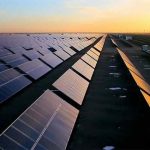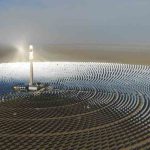
Xinjiang Hami Heliostat Chasing Light Power Generation
The “14th Five-Year Plan” is the key period and window period for carbon peaking, and China proposes to “strive to peak carbon dioxide emissions before 2030 and achieve carbon neutrality before 2060”. In photovoltaic, wind power and other new energy industries, solar thermal power stations have the advantages of continuous and stable output, in the context of “carbon peaking, carbon neutrality”, its thermal energy storage, 24-hour continuous power generation characteristics will become a major advantage to solve the new energy grid-connected consumption in the future.
In mid-June, in Naomaohu Town, Hamiyiwu County, Xinjiang, 14,500 heliostats were installed and commissioned, and Xinjiang’s first solar thermal power station entered a stable power generation period. Viewed from the air, the 14,500-sided sun-fixed mirror image is a huge “silver sunflower field”, and the scene is very spectacular. The project can achieve an annual power supply of 198 million kWh and save 61,900 tons of standard coal per year.
According to the documentary “Surging Power – Green Artery” broadcast by CCTV, Hami 50 MW molten salt tower solar thermal power generation project is located in Yiwu County, Hami City, Xinjiang, which is the first batch of solar thermal power generation demonstration projects in the country and the first solar thermal power generation demonstration project in Xinjiang. The project adopts today’s most advanced tower molten salt power generation technology, using the heliostat to reflect the sun just to the collector tower, through heat energy exchange, promote steam turbine generator power generation, the total planned capacity is two 50,000 kilowatt units, this phase to build a 50 MW tower molten salt solar thermal power station, a total investment of 1.58 billion yuan, the design annual utilization hours of 3980 hours, after the official put into operation, can provide 198 million kilowatt-hours of clean electricity to the grid every year.
It is reported that the Hami project has three major advantages, the first of which is the geographical location. Naomaohu Town, Hamiyiwu County, Xinjiang, where the project is located, is located in the eastern foothills of the Tianshan Mountains, which is one of the best areas of solar energy resources in China, with an average total solar radiation of about 6,200 megajoules per square meter, and 4,000 hours of light available throughout the year.
Secondly, the project adopts advanced tower molten salt power generation technology, using 14,500 heliostats arranged on the ground to reflect sunlight to the 181-meter heat-absorbing tower, the molten salt in the heat-absorbing tower absorbs heat, heats the molten salt of about 300 degrees Celsius into a high-temperature molten salt of 560 degrees Celsius, and then generates high-temperature and high-pressure steam through heat energy exchange to promote the turbine generator to generate electricity.
In addition, Hami project chose the first pentagonal monitor lizard heliostat in China, the load distribution is more uniform, the force characteristics are good, on the one hand, the curved round mirror invisible occlusion area is small, which is conducive to the effective use of land resources, on the other hand, the “heliostat” can be adjusted to “run after the sun” and maximize the lighting efficiency.
According to statistics from the National Energy Administration, in the first half of 2020, 11.52 million kilowatts of new photovoltaic power generation were installed nationwide, of which 7.082 million kilowatts were installed in centralized photovoltaics and 4.435 million kilowatts were installed in distributed photovoltaics. By the end of June, the cumulative installed capacity of solar photovoltaic reached 216 million kilowatts, including 149 million kilowatts of centralized photovoltaics and 67.07 million kilowatts of distributed photovoltaics. From the perspective of new installed capacity, North China and East China have more new installed capacity, reaching 439 and 2.19 million kilowatts respectively. We believe that solar thermal power generation integrates power generation and energy storage as a green power source that can replace fossil energy power stations as base load and peak shaving load, which plays an important role in ensuring the safety and efficiency of the power system and helping to achieve the goals of “carbon peak in 2030” and “carbon neutrality in 2060”.





